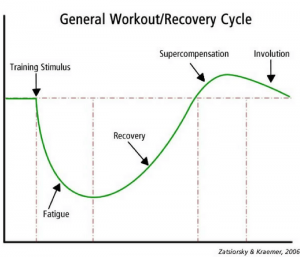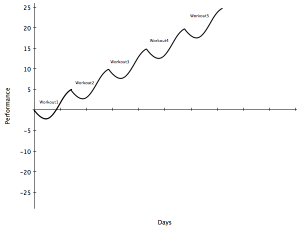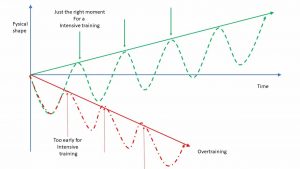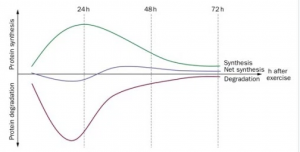How often should you train? The importance of understanding supercompensation curves.
December 12thThere’s often confusion around how and when training should be structured. Some practitioners will tell you to train more, some will say less. For example, it is quite common to read ‘perform daily’ on a rehab or training program and so to, for a more intense training program to read ‘perform 3-4 times per week’. Why is that? Are these numbers based on convenience? The answer comes with understanding the supercompensation curve.
WHAT IS SUPERCOMPENSATION
Supercompensation is a sports science term based on how to improve the output of the body. We know that we need to put in work, in order for our bodies to adapt and improve. We also know that if we train too hard, too often, we can begin to wear down the tissues and/or become injured. Therefore, understanding the supercompensation principles is key to optimising your adaptations and improve performance.
During a training session, when the body is exposed to load above a certain threshold and placed under significant stress, a small amount of ‘damage’ is caused. This decreases the body’s ability to complete similar tasks shortly after a training session. (Anyone who has been defeated by stairs following a leg workout knows this too well!)
 Figure 1: ‘The supercompensation curve’ highlights a graph from a 2006 paper outlining what happens after a workout/training session.
Figure 1: ‘The supercompensation curve’ highlights a graph from a 2006 paper outlining what happens after a workout/training session.
Immediately after the body is placed under stress, there is a significant decline in performance (fatigue) followed by a slow return to baseline (recovery). Following this, we see the supercompensation curve, where the body has an increased ability to tolerate the load exposed to the body.
If we allow the body to rest for too long (exposure to load/stressors) we lose our performance gains and return to baseline. However, if we re-expose the body to load again at the peak of the supercompensation curve, then we can increase performance. This phenomenon is highlighted below in Figure 2.
 Figure 2: ‘Re-exposure at the peak of the supercompensation curve’
Figure 2: ‘Re-exposure at the peak of the supercompensation curve’
OVERTRAINING
While it’s tempting to chase these performance gains on a daily basis, we have to understand that the recovery phase is just as important as the supercompensation phase. If we re-expose the body to load before we reach and exceed baseline then our overall performance will actually drop, and thus is known as over-training.

Figure 3: ‘Improving performance vs overtraining’ compares the improving performance through correct programming (green), and overtraining (red).
A common example of overtraining, is the individual who wants to run a marathon and runs daily, in to do so. More than likely, this individual will never reach their goal of consistently increasing their distance and/or pace and ultimately find each run harder than the previous.
In addition to overtraining and decreasing performance, this individual is more susceptible to injury, as the bodies capacity to tolerate load has decreased (this is the fundamental process of how overuse injuries occur).
HOW TO PROGRAM FOR DIFFERENT BODY TISSUES
It is crucial to know that different tissues of the body adapt at different rates. Muscle is the easy one, as we can often feel how long they take to recover. Normal muscle healing times are anything from 24-48 hours. Think about the last time you had an intense workout, how long were your muscles sore for?
When it comes to tendons however, the healing times are slightly longer, ranging from 48-72 hours (Figure 4). This is crucial for anyone undergoing rehab for a tendon injury.

Figure 4: – Tendon healing response times.
WORKING OUT ONCE OR TWICE PER WEEK – CAN YOU STILL IMPROVE?
In short, the answer is yes – though it does depend on how you measure improvement. We can see improvements in performance by simply practising the skill. The reason for this is due to neural adaptations and skill-based learning. Take a run for example, when we go for a run it is not just the muscles and tendons undergoing load that causes improvements, our brain and nervous system adapts and understands the experience of running. To put it another way, we get more co-ordinated at the skill of running. This happens in any movements we do, squat, bench press and burpee etc.
It is important to note, some drills/exercises are more appropriate for improving skill-based learning than others (e.g. Figure 5) and a skilled practitioner will program these in accordingly.

Figure 5: ‘The offset trap bar carry’ is a great skilled-based exercise.
However, just simply practising a skill will not suffice nor will it continue to improve your performance over the long term, as the gains due to neural adaptations only last for a short period (between 2 and 6 weeks depending on your skill level). It is also important to highlight that if you are increasing load (or distance – if we continue with the running analogy) while not in the supercompensation phase, then we are increasingly exposing the body to loads that it does not have the capacity to tolerate. Once again, this increasingly exposes the body to the possibility of injury.
To make consistent and long term adaptations to performance, we have to take in the above training principles and program accordingly. Understanding and incorporating these basic principles into your programming is essential in order to build solid foundations, so that you are able to progressively develop your body’s ability to perform an activity – whatever you choose that to be!
By Ashby Smith
Osteopath | Kinematics Strength + Recovery
